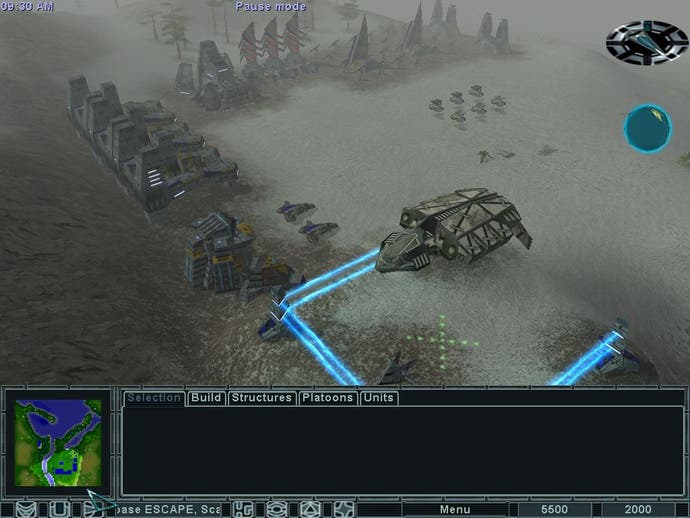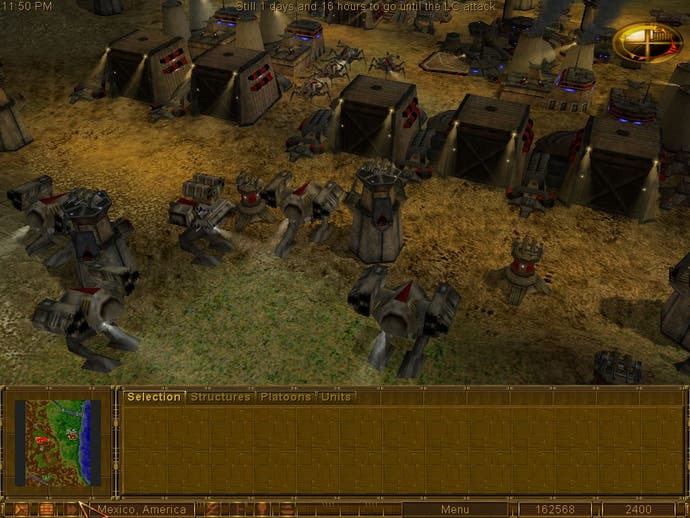Earth 2150: Lost Souls
Hands-On - fight for the lives of millions in the mist of a collapsing Earth
Earth 2150 is back after a gap of well over a year, and renamed development studio Reality Pump has polished the visuals and built a series of campaigns around the game's stunning graphics engine. We were lucky enough to get our hands on the first couple of missions in one of the campaigns, as well as the opportunity to skirmish with the AI to our heart's content. And boy was our heart content...

Found 'em!
The back-story is quite simple: Earth has had it. After years of warring and a series of nuclear explosions near the Antarctic, the Earth has started to spin off its axis, and according to the scientists of the Lunar Corporation, within the next few years it will do so by a staggering 17 percent, enough to bring about catastrophe. And so instead of fighting for supremacy, the three sides are fighting for survival, and the chance to escape the once proud green and blue blob three hops from the sun.
Lost Souls features three connected episodes centring on each of the game's factions: the Eurasian Dynasty, the Lunar Corporation and the United Civilized States. Over the course of thirty missions players, set on the Earth's four continents instead of the vast, barren wastelands of the moon as with last year's pseudo-sequel, players will control three characters. The first is General Fedorov of the Eurasian Dynasty, left in your control as he supervises and preps the escape shuttles and protects them from UCS and LC attacks. The player then moves on to a new recruit of the Lunar Corporation, protecting a secret project from ED attacks, and then Marcus Gordin of the UCS, a former defence minister. The plot will intertwine all three campaigns and promises twists and turns along with the usual plunder and domination.

Shiny happy units
As with The Moon Project, Reality Pump is upping the level of graphical detail, but unlike that game it should be easy to put visual tomfoolery to spectacular use. Settings will vary from the harsh icy wastelands of the Antarctic to the still-pretty greenery of the remaining continents in the West, with stopovers on the moon and elsewhere, each resplendent with pools of animated, semi-transparent water and flooded with dynamic lighting. The full day and night cycle means managing your units lighting just as much as it does their other vital functions, and each unit has a headlight function too, so in the dead of night, when you most fear an attack, it might be best to have them facing outward and not simply clustering in the centre of the base.
Other effects tickling the belly of our graphics card include some glorious bump mapping, obviously useful on the surface of the moon, as well as fog, snow, rain and lightning weather effects. Reality Pump has also built in dynamic shadows to match those lighting effects, and what's more, shadows actually lengthen as the day draws on, not just cast by units but also terrain, so you might want to think twice about building your base at the foot of a mountain unless you want to keep the lights on most of the time - at the cost of a great deal of energy, which your power plants won't thank you for having to pump out. Unit and building detail hasn't suffered in the wake of all these special touches either, with designs still standing up to closer inspection.

Strategy
Research trees are still extensive, and the complexity will have you scratching your head in search of the best path. Unit diversity is also assured. A stealthy batch of armoured vehicles may sneak through radar screens undetected allowing you to compromise an enemy's base and plunder it when they aren't expecting it, but you could almost certainly build greater numbers of the same armoured vehicles without the added cost of stealth. Is it worth it? Therein lies the strategy.
So far it's easy to build up a varied force and the typical mouse controls and easy keyboard shortcuts mean it takes little effort to manipulate your forces in battle. What's more, you can get a better view of things by rotating the camera and raising or lowering the angle. The mechanics of the game are still very much build-and-destroy with a few added objectives thrown in for good measure, but it's nice to be able to do things in comfort and without cursing the engine every five seconds.
At this stage, it's difficult to say how the three campaigns will turn out in their entirety, but for now the setting and mechanics are very promising. Skirmish mode offers plenty of options for extended play, and of course you can tweak the various settings that govern your starting parameters. Lost Souls may not make sweeping changes to the real-time strategy formula, discarding accepted methodology and so on, but it does seem to be a good old-fashioned RTS game, and it may well be worth a look when its September release date dawns. Just don't forget to turn the headlights off.

